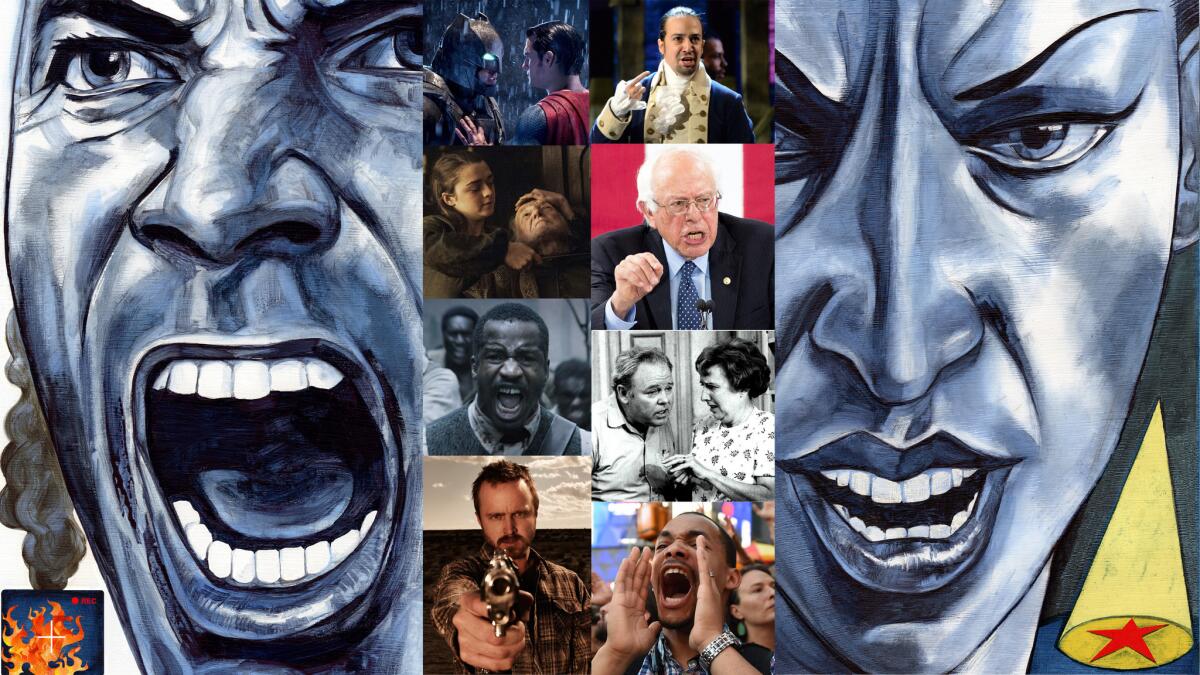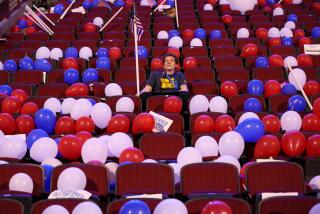How an angry national mood is reflected in pop culture

Our screens and phones fume with righteousness. Our superheroes have forsaken us and our fictions pale against our headlines. Social media taunts have poisoned our political discourse and disfigured our reality. We have become an angry, fractious lot, a âGame of Thronesâ for a digitized and unsettled century.
Much of our vexation arises from the insecurities of white working and middle classes threatened by a country reimagined by Wall Street, globalization, technology and changing demographics. The backlash has agitated racial tensions and identity politics that played out in the presidential campaigns of Donald Trump and Bernie Sanders but also reverberated beyond our borders to a world shaken by financial crises, Britainâs vote to exit from the European Union, waves of Syrian refugees and terrorist attacks in Paris, Brussels, Baghdad and San Bernardino.
Visceral and at times frightening narratives are running through our popular culture. We get Batman and Superman â once the extensions of our better selves â battling each other in a grim rain; the take-no-prisoners TV commentaries of Samantha Bee and John Oliver; abrasive, if clever, comics like Amy Schumer; rage and betrayal in Beyonceâs âLemonadeâ; meth and degradation in âBreaking Badâ; beheadings, dragons, torture and wars for supremacy in âGame of Thrones.â
Ta-Nehisi Coatesâ âBetween the World and Me,â a bestselling meditation on being a black man in America, is, along with Kendrick Lamarâs Grammy- winning âThe Blacker the Berry,â among the most profound expressions on anger and disillusionment around race. Two of last yearâs most heralded films reflected fury that, while set in the recent past, connects with the current political turmoil: âThe Big Shortâ was an examination of the greed and hubris that led to the 2008 financial collapse, calling out a Wall Street culture that has become a target of populist politics, while âStraight Outta Comptonâ reminded audiences of the LAPDâs brutal history with minority communities as new police shootings of African Americans set off disturbances across the nation.
Such works reflect the darker elements of our natures at a time when our realities seem more perilous than our make-believes. The canon of art is to make sense of seminal times, to pull insight from extremity and find universal meaning in uproar â thatâs what powered much of pop culture through turbulent times like the Vietnam War or the Great Depression. But our anger today in the arts is aimed at narrower audiences and amplified through social media and appears more pulse-pounding and instantaneous than in past decades.
Our predilections both in popular culture and politics have increasingly turned tribal, as if a once-common language has broken into coded dialects that separate us from the other. Our entertainment options, many of them self-produced on Facebook, Snapchat and YouTube, are plugged into multiple platforms. Our invective is searing, and our common ground is shrinking in a competitive and raucous media landscape that refracts and fuels our worst instincts.
MORE: Tom Morello on why activism in music matters: âDangerous times demand dangerous songsâ Âť
Where are the broader signposts and what are the cultural descendants of Neil Youngâs âOhioâ or Jimi Hendrixâs assaultive rendition of the âStar-Spangled Bannerâ? Where is Bob Dylanâs âThe Times They Are a Changinââ or Marvin Gayeâs âWhatâs Going Onâ? Where are Archie Bunkerâs rants, Paddy Chayefskyâs screenplay for âNetworkâ or Norman Mailerâs âThe Armies of the Nightâ?
âArt is so fragmented. Weâre off in our own ghettos,â said Charles Randolph, who co-wrote the screenplay for âThe Big Short.â He added that social media and other outlets offer few galvanizing touchstones, such as the original 1977 television miniseries âRootsâ (not this yearâs remake, which had a fraction of the originalâs audience), that resonate across race, economic class and culture.
âI donât see the traditional players coming along and doing what they do,â he said. âBut you also donât see younger artists articulating the universal anger.
âWhy hasnât any artist done the job of a crazy politician from New York?â Randolph said in reference to Donald Trump, the presumptive Republican nominee who has channeled and amplified widespread dismay with public and financial institutions. Trump will headline what is expected to be a messy convention in Cleveland that begins Monday.
Artistic dilemma
Writers and artists have long faced dilemmas on tapping into the zeitgeist. Some suggest art should arise immediately from the times it is articulating; others say art and popular culture best define landmark moments through a dispassionate prism of time and distance.
Philip Roth, in a 1961 essay, was perplexed over how to decipher a nation entering a decade of turmoil: âThe American writer in the middle of the 20th century has his hands full in trying to understand, and then describe, and then make credible much of the American reality. It stupefies, it sickens, it infuriates and finally it is even a kind of embarrassment to oneâs own meager imagination. The actuality is continually outdoing our talents, and the culture tosses up figures almost daily that are the envy of any novelist.â
Even the most socially attuned artists would have been hard-pressed over the last year to conjure anything as dramatic or revealing as the moods and faces at rallies for Trump and Sanders. The presidential campaign, notably during the Republican primary, has given us populist passions in a real-time mash-up of a âSaturday Night Liveâ skit and an updating of novelistâs Robert Penn Warrenâs political masterwork, âAll the Kingâs Men.â
MORE: Donald Trumpâs presidential campaign is fueled by an anger the media didnât see coming Âť
âIâll say this about Trump: Anger is an addiction. We like it. The brain likes it. And now youâve got a country full of addicts,â Paul Simon was quoted as saying by Billboard magazine. âAnd the media and certain politicians are the dealers. So everybodyâs angry all the time, and theyâre all juiced up. Iâm not saying thereâs nothing to be angry about. What Iâm saying is, you canât make a calm decision when somebodyâs got you in a rage.â
One wonders how Archie Bunker would view todayâs America from his living room in Queens. A bigot and a racist who wore white socks with black shoes, Archie (Carroll OâConnor) was the embattled everyman of the 1970s groundbreaking television sitcom âAll in the Family.â With his flag-pin patriotism, Archie, as politically incorrect as a man could be, clung to a past that was vanishing around him. But everyone knew the joke was on him; his insufferability allowed him our sympathy, or if not that, at least our understanding. Itâs hard to imagine that attitude of amused tolerance for a character like Archie today.
But Archieâs was a time when much of American popular culture was distilled through three TV channels, a dial of radio stations, family-owned movie houses, newspapers and weekly magazines. Today talk radio, reality shows and legions of blogs tap into and stoke anger.
The era of hashtags and selfies has given rise to political expression and art that are instant and fiercely personal. Facts matter less than egos; swift thumbs and eviscerating texts have little time for context. A similar reckoning for cultural and political forces roiled civil rights protests and anti-Vietnam War marches of the 1960s but, except for certain pockets including the South, there were moments of shared purpose amid the many convulsions.
âBobby Kennedy sat with Cesar Chavez. You had Woodstock and a racially multicultural effort that was the impulse of the â60s,â said Dawn Porter, documentary film director of âGideonâs Armyâ and âTrapped.â âBut today weâre more separate and you have to cross a line. It is very dangerous. People at Trump rallies, itâs pretty scary stuff. I donât see someone [an artist or musician] speaking to a multiracial audience. Itâs odd. I canât see a Trump supporter sitting with a person from Black Lives Matter. Who would be their headliner?â
Art has illuminated pivotal moments and forced evaluations throughout American history. The Depression-era photographs of poor families taken by Margaret Bourke-White, Walker Evans and Dorothea Lange captured the publicâs imagination. Woody Guthrieâs folk song âThis Land Is Your Land,â written in 1940 and released years later, was a blistering counterpoint to Irving Berlinâs âGod Bless America.â Playwright Arthur Millerâs âDeath of a Salesmanâ resonated with the cruelty and tragedy of the American dream in the immediate post-World War II years.
This yearâs two big Tony winners reflect these separate realities. The multicultural cast of the Broadway sensation âHamilton,â a musical about founding father Alexander Hamilton, embodies the nationâs diversity. Playing not far away is âThe Humans,â a potent rendering of the dashed expectations of the white middle class, including a line that crystallizes our economic fears: âDonât cha think it should cost less to be alive?â
MORE: In defense of anger: A criticâs appeal to playwrights to let their tempers fly Âť
Different fears are realized in Ayad Akhtarâs Pulitzer Prize-winning âDisgraced,â just finishing its run at the Mark Taper Forum, about the stewing torment of a Pakistani American lawyer torn between his Muslim ancestry and his Western aspirations. In a recent interview, Akhtar said he was struck by how much the dramatic language of the theater has often been eclipsed by the knives-out vernacular of the real world.
âI wrote the play in 2010 and I didnât think that that kind of degradation of rhetoric could exist anywhere but the theater,â he said. âBut now weâre living in a world where whatâs happening on stage is not all that controversial. Itâs happening everywhere, all the time, about shifts in American life.â
Our rage these days often cuts deeper than our sense of humor. There are fewer agreed-upon pathways that allow us to examine together our transgression, foibles, prejudices and fears. Our shared humanity has been demarcated on smaller and smaller screens that often brim more with quicksilver judgment than open-mindedness. The lines have hardened. The terrain is vast and splintered, and as the lyrics of Lamarâs âThe Blacker the Berryâ suggest, self-loathing may bristle beneath the rancor:
âI mean, itâs evident that Iâm irrelevant to society / Thatâs what youâre telling me, penitentiary would only hire me / Curse me till Iâm dead / Church me with your fake prophesyzing that Iâmma be just another slave in my head / Institutionalize manipulation and lies / Reciprocation of freedom only live in your eyes / You hate me donât you? / I know you hate me just as much as you hate yourself.â
MORE:
On TV, rage has become the new romance
Anger is an energy for a new wave of women in pop culture
More to Read
The biggest entertainment stories
Get our big stories about Hollywood, film, television, music, arts, culture and more right in your inbox as soon as they publish.
You may occasionally receive promotional content from the Los Angeles Times.











